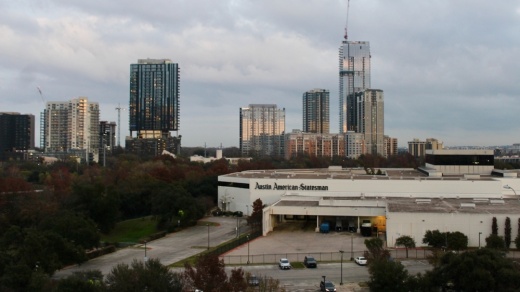The rezoning of 305 S. Congress Ave., currently home to the Austin American-Statesman, came before council this spring after moving through city staff and commission reviews over recent months. The so-called Statesman PUD, or planned unit development, as proposed features 1.65 million square feet for residences, 1.5 million square feet of offices, 150,000 square feet of retail space and a 275-room hotel.
The 3.52 million square feet of commercial space centers around a series of high-rises stretching as high as 525 feet above Lady Bird Lake alongside new public roadways and acres of waterfront parkland.
Council's April discussion resulted in a vote in favor of the PUD plan on first reading only with more remaining questions and final details still to be worked out for the required second and third readings before city officials. Much of the conversation centered on the scale of the community benefits offered by developers Endeavor Real Estate Group and the Cox family, including how the project could support the housing, mobility and recreational needs of the public in addition to future residents of the luxury condominiums or apartments on-site.
“I think this is a tremendous opportunity for the city of Austin," District 9 Council Member Kathie Tovo said. "I have a keen interest in seeing it move forward in a way that it really becomes a community asset.”
Finding the right balance for the PUD's housing component has been one of the focal points for reviews by council and city commissioners. Austin Planning Commission members passed an amended PUD plan in February that includes a higher ratio of affordable units offered at lower rates than initially proposed. Council is also weighing changes to the scope of several dozen affordable spaces planned out of nearly 1,400 total residential units and whether the city could immediately collect fees from the project to support efforts to shelter and house the homeless.
In addition to affordable housing, the development team and city staff have pointed to plans for a revitalized waterfront park and bat viewing area, mobility improvements including an extension of Barton Springs Road and a massive underground parking garage as some of the key benefits of the project. If realized, they said those features are worth the extra entitlements—such as several stories of additional building height—the city would be granting with the PUD. With plans still under review, the exact trade-off between such benefits and city allowances is still up for debate.
“While the Cox family and Endeavor are willing to shoulder the costs of many of the community benefits, the end product has to make financial sense. Which means we have to have the conversation, and push-pull and the give-gets of the community benefits," said Richard Suttle, a land use attorney representing the development team.
The project also garnered a mixed response from several members of the public who spoke to the plans earlier during the council session. Some residents said the plans for new parkland and high-rises on Lady Bird Lake represent an upgrade over the current site with sufficient community benefits, while others spoke against the city's review process and the lack of firm details for the public to look over.
In the end, council moved pieces of the PUD proposal along in a vote Tovo dubbed "round one" of planning and negotiations between city staff and developers. The outline passed April 7 was based on a framework from the planning commission including nearly two dozen amendments related to affordability, transportation, and other land use and oversight measures. Council also approved the PUD items with a motion sheet from Tovo covering topics such as building reflectivity, Americans with Disabilities Act-compliant accessibility and housing affordability that will come up in ongoing project talks.
"Overall, I think what we on this dais need to assess is whether the community benefits are commensurate with the request for increased entitlements, as well as, is this the kind of transformation we want on this site? And I think, largely, it is the kind of transformation that we want on this site," Tovo said. "And so now, as I see our charge, it is to do that cross-benefit analysis and determine whether the community benefits are commensurate. ... I do think there’s a lot of conversation that needs to happen around that point."
The PUD plans will likely take "a little while" to appear before council again for potential approval, according to city staff, as negotiations based on the latest city directives continue.
Tovo also requested comprehensive updates from staff covering details of a proposed tax increment reinvestment zone, or TIRZ, that would cover more of the South Central Waterfront area. A TIRZ would allow a portion of city property tax increases collected within the zone to be used on localized improvements rather than flowing straight into Austin's general fund, and it has been met with some reservations both in the community and on the dais.
The Statesman PUD team has said much of their plan, including the full public park and lower-cost residences, cannot take shape as proposed without that civic financing mechanism in place.
"We won’t build the plan if there’s no TIRZ; it just doesn’t work," Suttle said in December.





